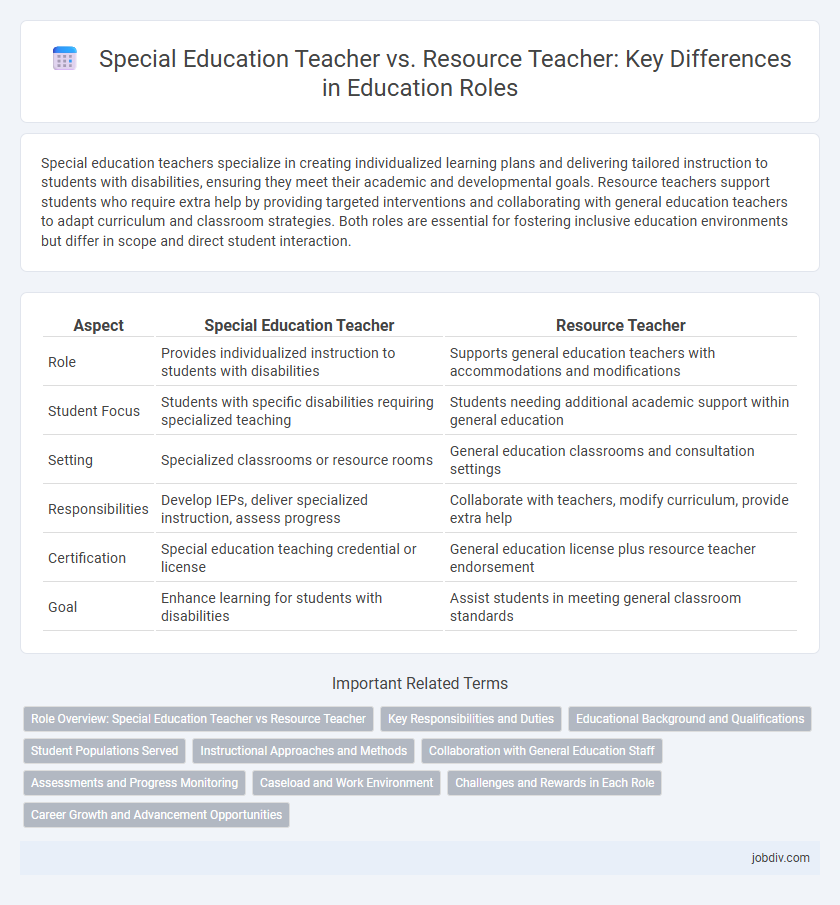Special education teachers specialize in creating individualized learning plans and delivering tailored instruction to students with disabilities, ensuring they meet their academic and developmental goals. Resource teachers support students who require extra help by providing targeted interventions and collaborating with general education teachers to adapt curriculum and classroom strategies. Both roles are essential for fostering inclusive education environments but differ in scope and direct student interaction.
Table of Comparison
| Aspect | Special Education Teacher | Resource Teacher |
|---|---|---|
| Role | Provides individualized instruction to students with disabilities | Supports general education teachers with accommodations and modifications |
| Student Focus | Students with specific disabilities requiring specialized teaching | Students needing additional academic support within general education |
| Setting | Specialized classrooms or resource rooms | General education classrooms and consultation settings |
| Responsibilities | Develop IEPs, deliver specialized instruction, assess progress | Collaborate with teachers, modify curriculum, provide extra help |
| Certification | Special education teaching credential or license | General education license plus resource teacher endorsement |
| Goal | Enhance learning for students with disabilities | Assist students in meeting general classroom standards |
Role Overview: Special Education Teacher vs Resource Teacher
Special Education Teachers design and implement individualized education programs (IEPs) for students with disabilities, focusing on specialized instruction tailored to diverse learning needs. Resource Teachers provide targeted support by collaborating with general education teachers to assist students requiring supplementary help, often within the general classroom setting. Both roles aim to enhance student achievement but differ in direct instructional responsibilities and integration levels.
Key Responsibilities and Duties
Special Education Teachers develop individualized education programs (IEPs) tailored to students with disabilities, delivering specialized instruction and behavioral support to enhance learning outcomes. Resource Teachers provide targeted academic assistance, collaborating with general education teachers to adapt curriculum and accommodations for students requiring additional support. Both roles emphasize student progress monitoring, family communication, and adherence to educational regulations to ensure inclusive and effective learning environments.
Educational Background and Qualifications
Special education teachers typically hold a bachelor's degree in special education or a related field and require state licensure or certification specific to special education, emphasizing skills in individualized instruction for students with disabilities. Resource teachers often possess a teaching certification along with specialized training or endorsement in resource or remedial education, enabling them to support students with learning difficulties within general education settings. Both roles demand knowledge of individualized education programs (IEPs) and collaboration with multidisciplinary teams to address diverse student needs effectively.
Student Populations Served
Special education teachers primarily serve students with disabilities, including learning, mental, emotional, and physical challenges, tailoring individualized education programs (IEPs) to meet diverse needs. Resource teachers support students requiring extra assistance within general education settings, focusing on academic interventions for those with mild to moderate learning difficulties. Both roles collaborate to enhance student outcomes but differ in intensity and scope of specialized services provided.
Instructional Approaches and Methods
Special education teachers employ individualized instruction tailored to students with disabilities, incorporating strategies such as differentiated instruction, multisensory learning, and assistive technology to address diverse learning needs. Resource teachers provide targeted support within general education settings, using consultative methods and specialized interventions to reinforce core curriculum while promoting inclusion. Both roles emphasize collaboration with general educators to adapt instructional materials and implement evidence-based practices enhancing student engagement and achievement.
Collaboration with General Education Staff
Special education teachers work closely with general education staff to adapt curricula and provide individualized support for students with disabilities, ensuring accessible learning environments. Resource teachers collaborate by offering supplemental instruction and targeted interventions within general education classrooms to address specific student needs. Effective teamwork between these professionals enhances student outcomes through shared expertise and consistent communication strategies.
Assessments and Progress Monitoring
Special education teachers conduct comprehensive assessments to identify individual student needs and create tailored instructional plans, while resource teachers use these assessments to provide targeted intervention within general education settings. Progress monitoring involves special education teachers frequently evaluating student performance to adjust specialized strategies, whereas resource teachers focus on tracking improvements in specific skill areas to support inclusion and collaboration. Both roles utilize data-driven approaches to ensure effective student growth and achievement.
Caseload and Work Environment
Special education teachers typically manage smaller caseloads of students with diverse disabilities, providing individualized instruction within inclusive or self-contained classrooms. Resource teachers handle larger caseloads but offer targeted support services, such as academic interventions, in pull-out settings or general education classrooms. Work environments differ as special education teachers spend more time coordinating with multidisciplinary teams, while resource teachers focus on collaborative consultation with classroom teachers.
Challenges and Rewards in Each Role
Special education teachers face challenges such as adapting curriculum to diverse learning needs and managing behavioral issues while experiencing rewards through fostering student growth and inclusion. Resource teachers encounter obstacles in providing targeted support within general education settings and coordinating with multiple educators yet gain satisfaction from improving individualized student outcomes and promoting collaborative learning environments. Both roles demand patience, creativity, and dedication, offering unique fulfillment by directly impacting students' academic and social development.
Career Growth and Advancement Opportunities
Special Education Teachers often advance into leadership roles such as Special Education Coordinators or Directors, leveraging specialized skills in individualized education programs (IEPs) and behavioral interventions. Resource Teachers typically transition into roles that focus on curriculum development, instructional coaching, or academic support services, emphasizing collaboration with general education staff. Both career paths offer opportunities for professional development and higher certification, but Special Education Teachers tend to have more avenues for administrative positions within special education programs.
Special Education Teacher vs Resource Teacher Infographic

 jobdiv.com
jobdiv.com